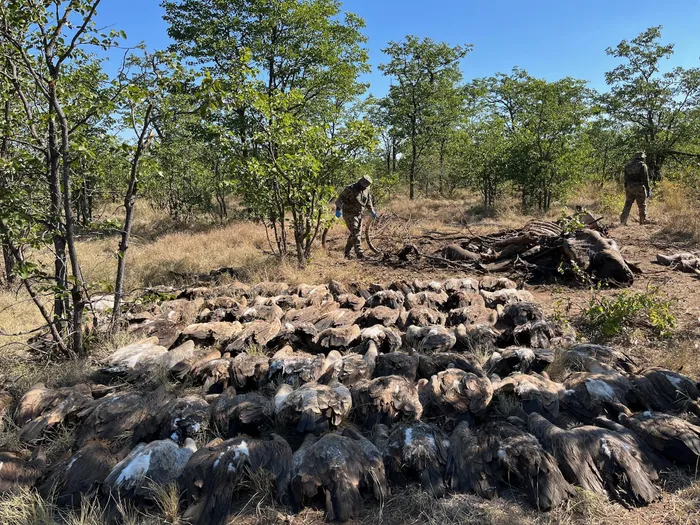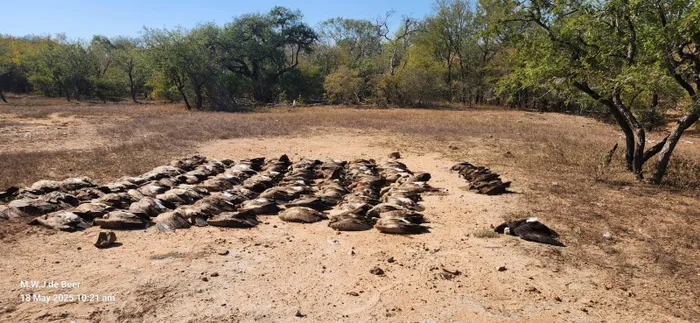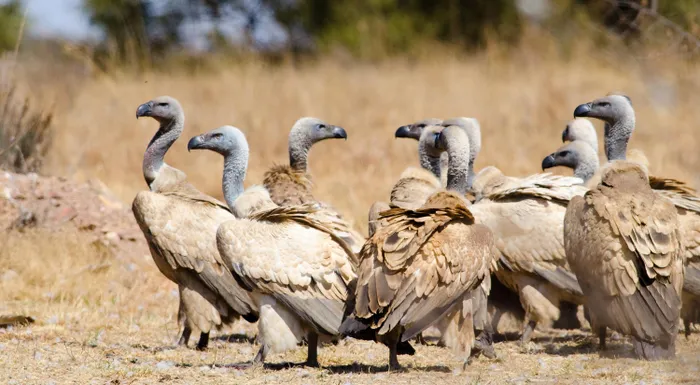New poisoning tactics threaten South Africa's endangered vultures

More than 100 vultures, all endangered, died in a mass poisoning in the Kruger National Park.
Image: Supplied.
SOUTH Africa is facing what conservationists call a growing and coordinated threat to endangered wildlife, following two mass vulture poisoning incidents in the space of just over a week — one in Kruger National Park and another in Lionspruit Game Reserve, Mpumalanga. Combined, these events have killed over 220 vultures, a devastating blow to already fragile populations.
Experts warn that such poisonings are not isolated but point to an emerging poaching tactic using laced carcasses to eliminate vultures — which often alert authorities to wildlife crimes — and possibly divert attention from larger operations.
On 18 May, VulPro and Wild and Free Wildlife Rehabilitation Centre confirmed the deaths of over 100 vultures at Lionspruit near Marloth Park. The site was identified via GPS signals from previously rehabilitated vultures. Responders found dozens of birds dead around a poisoned warthog carcass. There were no survivors.
The victims included 92 White-backed Vultures (90% breeding adults), nine Hooded Vultures, and one White-headed Vulture — all Critically Endangered. No body parts were removed, indicating the motive was likely not linked to traditional medicine practices.
“The scale of this poisoning is devastating and appears to be part of a much bigger, targeted operation,” said Kerri Wolter, CEO of VulPro. “We are genuinely terrified of what next is going to occur.”
Samples were collected for toxicological testing, which may lead to legal action. Wolter has appealed to all rehabilitation centres in the Lowveld to halt vulture releases until threats are assessed.
“This is not just about one event. It’s about a systemic threat to our natural balance,” she added.
Just days earlier, on 7 May, a similarly horrific incident took place in Kruger National Park’s Mahlangeni Section. SANParks has confirmed it as one of the largest mass vulture poisonings in Southern Africa, with 123 birds killed and 84 rescued in what became a landmark emergency operation.
According to JP Louw, SANParks Head of Communications, “The incident is one of the largest seen in the park. A total of 116 vultures were found dead at the scene.”

100 Vultures were found dead just a week after the Kruger National Park incident
Image: Supplied
Rangers discovered the poisoning at a laced elephant carcass. Two vultures were barely alive and received on-site treatment. A multi-agency effort followed, including teams from Moholoholo Wildlife Rehabilitation Centre, Briner and Wildscapes Veterinary Services, and SANParks aerial support. This marked the first time SANParks deployed helicopters for a poisoning rescue of this scale.
Eighty-four vultures — including White-backed, Cape, and Hooded species — were rescued. Most were transported via the EWT’s specialised vulture ambulance or airlifted to SANParks’ Phalaborwa K9 facility. A remarkable 96% survival rate was achieved.
“This marks one of the most extensive coordinated response and rescue efforts to date,” Louw said, noting that early detection systems and NGO collaboration played a critical role.
These events form part of a wider, growing crisis: the use of agricultural poisons in poaching to target both vultures and species like lions, whose body parts are in demand for muthi.
“This is a setback for the vulture population in the Greater Kruger landscape,” said Louw. “SANParks continues working with agencies to address this rise in poisoning events.”
Despite the scale of the event, SANParks has not yet issued a formal appeal to the National Wildlife Poisoning Prevention Working Group (NWPPWG).
Peter Mbelengwa, head of communication and advocacy at the Department of Forestry, Fisheries and the Environment, confirmed that the department is aware of the incidents
“SANParks will continue to update the Department on the progress of investigations through official channels.”
Mbelengwa said the department has been actively involved in efforts to address wildlife poisoning and is committed to regulating the sale and use of agrochemicals.
“The National Wildlife Poisoning Prevention Working Group (NWPPWG) is working to ensure that agricultural pesticides are responsibly imported, sold, stored, and disposed of. Our goal is to eradicate the illegal use of pesticides and prevent their use in wildlife crimes,” Mbelengwa explained.
“The devastating impacts of poisoning on vultures highlight the urgent need for coordinated conservation efforts,” Mbelengwa continued.

Vultures are also listed on the endangered species list.
Image: Supplied
“South Africa’s vultures are facing significant threats, with three of the seven resident species listed as Critically Endangered. Without effective conservation actions, these species could become extinct in the near future.”
In response to this growing crisis, Mbelengwa pointed to the recent publication of a Multi-species Biodiversity Management Plan for Vultures, which is now being implemented. “This plan, developed by the Minister, aims to recover vulture populations to acceptable levels by 2033,” Mbelengwa said. “It is vital that we work both nationally and internationally to address the challenges vultures face.”
“We will continue to support SANParks and NGOs in their efforts to detect and respond to wildlife poisoning. Our commitment to protecting South Africa’s biodiversity remains unwavering,” he concluded.
tracy-lynn.ruiters@inl.co.za
Weekend Argus